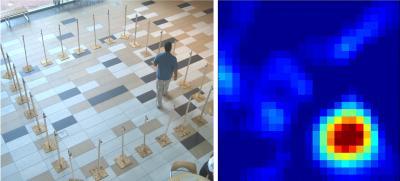
© Sarang Joshi and Joey Wilson, University of UtahOn the left, a person walks around inside a square of 28 radio transceivers in the Warnock Engineering Building's atrium at the University of Utah. The person creates "shadows" in the radio waves, resulting in the image displayed on right, in which the person appears as a reddish-orange-yellow blob.
University of Utah engineers showed that a wireless network of radio transmitters can track people moving behind solid walls. The system could help police, firefighters and others nab intruders, and rescue hostages, fire victims and elderly people who fall in their homes. It also might help retail marketing and border control.
"By showing the locations of people within a building during hostage situations, fires or other emergencies, radio tomography can help law enforcement and emergency responders to know where they should focus their attention," Joey Wilson and Neal Patwari wrote in one of two new studies of the method.
Both researchers are in the university's Department of Electrical and Computer Engineering - Patwari as an assistant professor and Wilson as a doctoral student.
Their method uses radio tomographic imaging (RTI), which can "see," locate and track moving people or objects in an area surrounded by inexpensive radio transceivers that send and receive signals. People don't need to wear radio-transmitting ID tags.

